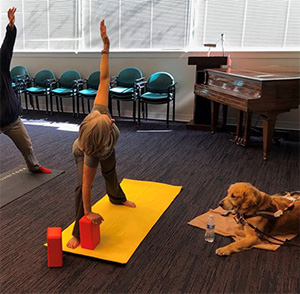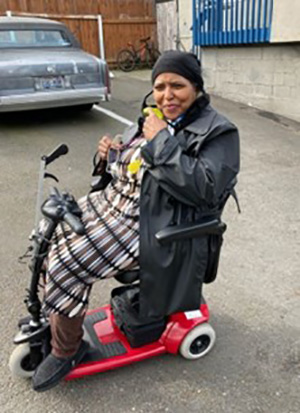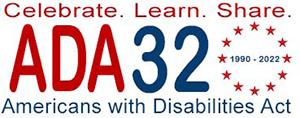The ADA and the Benefits of Assistive Technology

As we celebrate the Americans with Disabilities Act (ADA), which was signed into law 32 years ago, it is a good time for us to reflect on how this law’s comprehensive set of civil rights and protections guarantee equal opportunity for individuals with disabilities in public accommodations, employment, transportation, state and local government services, and telecommunications.
This guarantee of equal opportunity mandates accessibility and accommodations for persons with disabilities. These are the ramps and frameworks that allow persons with disabilities to be fully participating and contributing independent individuals who are able to navigate the world—physical and virtual. They will get to where they need to go and receive the information they are looking for.
The ADA defines a person with a disability as a person who has a physical or mental impairment that substantially limits one or more major life activity. For many of us, the process of aging includes not always being able to do the things we could when we were younger. Things may be harder to read. You may need to use a hearing aid to listen and communicate. Getting up and down stairs isn’t as easy as it once was. Many of us benefit from the ADA without ever realizing it, as those rights and protections are there for all of us. To learn more, visit the ADA National Network and our local Northwest ADA Center.
But many older adults and persons with disabilities also need assistive technology (known as AT) to accomplish a task. AT is often described as technology that helps level the playing field and make everyday aspects of living possible.
AT—any product or service that makes tasks easier or possible

Camille is practicing yoga on a mat designed for those with vision challenges—the bright yellow yoga mat color contrasts with the floor; the mat’s raised center line helps to orient the user on the mat and in class; and the three-dimensional design, which includes strategically placed raised and depressed features, helps the user feel where her hands, feet, and head should be placed for safe alignment in yoga poses. Camille uses the mat regularly to practice safely and independently.
The Assistive Technology Act of 2004 defines assistive technology as “any item, piece of equipment, or product system … that is used to increase, maintain, or improve functional capabilities of individuals with disabilities.” (Public Law 108-364, Sec. 3(4))
What does “functional capabilities” mean? Broadly speaking, a functional capability (or functional need) is the ability to accomplish a task (or not), whether in school, at work, at home, or in the community. Tasks could be as simple as opening a tightly sealed jar or as complex as being able to see what is on your computer screen.
Today, many people use simple daily living aids such as long handled shoehorns to put on shoes, levers rather than knobs to open doors, and daily pill organizers to take medications on time. These simple aids help many of us to dress, cook, read, hear, and get around. These are examples of AT.
Many of us also use smart phones and computers to organize our lives, find information, and communicate with family and friends. Some of us use features on these devices to make the text larger, increase the volume, dictate messages into texting programs, or ask a digital assistant to find out when a store is open or for directions. Again, these are examples of AT that many of us are familiar with. Often, we don’t give any thought to how useful these technologies are and how they help us every day.
AT can be more complex, but once set up, allow you to accomplish many tasks independently. Smart home technology can be used to make lives easier by interacting with your home environment by remote control, including using one’s voice to give commands. One can answer a doorbell, see who is at the door, and remotely unlock a door to let someone in using a smart lock system. You can turn on and off lights throughout the home or dim and brighten lights using smart bulbs. You can control a thermostat, have a book read aloud to you, play music, or have a video call with a friend, all using a digital assistant like Amazon Echo, Google Home, or Apple HomeKit.
AT also includes magnification and screen reading technologies, hearing assistance devices, accessible kitchens and bathrooms, and ramps and lifts. Adapted vehicles and recreational equipment, including off-road wheelchairs and modified bikes, are additional examples.
Why the selection process is important

Linda received a small electric scooter from the Meyer Medical Equipment Center, operated by WATAP’s device reuse partner, Bridge Disability Ministries, small enough to fit in her apartment but with enough power to get her up the hill to the grocery store.
There is widespread underutilization of AT among older adults, persons with disabilities, caregivers, and professionals. A lack of available resources contributes to this underutilization, including how and where to find information about AT, how one uses the technology, where one finds training and support, where one can purchase the technology, and what funding resources are available to help pay for the technology.
Older people are often subject to social isolation, medical decline, and decreased functional ability. In particular, hearing and vision loss affect communication, and reduced dexterity and mobility deter some older people from participating in community activities.
Senator Elizabeth Warren stated in a 2019 hearing on the Older Americans Act that “maintaining health at home is efficient and cost effective and compassionate”; however, available services are complex and difficult to navigate, and older people often do not identify with the disability community. AT needs that can help maintain independence and promote aging in place are often not addressed. Additionally, family caregivers are under-supported, especially with regards to AT that could make care more manageable.
Up to 50 percent of all AT is abandoned. Why is that? First, there are many AT options—there needs to be a good process to help identify best choices. If a user’s preferences or environment were not considered; a device is purchased without trying it out; training, follow up and/or repairs were not received, or functional capabilities changed and the AT in use could not accommodate change … the AT may go unused. A good selection process will take all these factors into consideration before AT is selected and purchased.
The Washington Assistive Technology Act Program
 The Washington Assistive Technology Act Program (WATAP) offers resources and services to persons who face challenges related to disability and aging that can help in the selection and use of AT. WATAP serves older adults and persons with disabilities as well as their circles of support—family members, caregivers, employers, service provider professionals, educators, and others seeking AT expertise.
The Washington Assistive Technology Act Program (WATAP) offers resources and services to persons who face challenges related to disability and aging that can help in the selection and use of AT. WATAP serves older adults and persons with disabilities as well as their circles of support—family members, caregivers, employers, service provider professionals, educators, and others seeking AT expertise.
WATAP helps find technology solutions for increasing and maintaining independence, including addressing such common needs as computer access, home accessibility, daily living aids, and mobile communication. WATAP’s device demonstration and device lending programs help guide the AT selection process and focus on the functional need that an individual believes could be helped with AT. The individual makes an informed decision about features and options that are best for them and tries various AT devices to confirm that it will work, or they try something else.
In this process, WATAP’s specialists help by providing the expertise and information necessary to inspire creative thinking in finding solutions. Device demonstration is guided exploration of the features and options of AT devices with an experienced AT specialist. The person may then borrow a device that looks promising through WATAP’s short-term device lending program and try it out at home, school, or work. Again, these programs are designed to assist in informed decision-making, enabling people to make confident choices about AT needs.
WATAP works with community partners to offer alternative means to help individuals obtain AT. Through partnership with the Perkins School for the Blind, WATAP offers iCanConnect WA, Washington’s National Deaf-Blind Equipment Distribution Program. This program provides telecommunications equipment and associated support and training to eligible low-income applicants who have combined vision and hearing loss.
WATAP also partners with the Northwest Access Fund, which offers affordable financing for the purchase of AT devices, including hearing aids, dentures, adapted vehicles, and home accessibility modifications.
WATAP’s community device reuse provider is Bridge Disability Ministries’ Meyer Medical Equipment Center, which provides reused mobility and durable medical equipment and daily living aids at no cost. Effective reuse of assistive devices makes a positive impact to the environment, improves the quality of life of users, and often results in significant cost savings.
Challenges remain, but AT makes a difference. Having fully participating independent individuals with a spectrum of ability and disability is a necessary part of a truly inclusive, diverse, and integrated society.
The impact of AT is felt not only by the individuals themselves, but also by their immediate families, and the community at large as persons with disabilities. We thank the ADA for the protections and recognize AT for the help it provides!
 Contributor Alan Knue is the director of WATAP—the Washington Assistive Technology Act Program. He serves on the Northwest Universal Design Council, which is staffed by Age Friendly Seattle.
Contributor Alan Knue is the director of WATAP—the Washington Assistive Technology Act Program. He serves on the Northwest Universal Design Council, which is staffed by Age Friendly Seattle.
 July 26 Anniversary of the ADA
July 26 Anniversary of the ADA
Here are some ideas for ways you can acknowledge the 33nd anniversary of the Americans with Disabilities Act:
- If you or your organization have a website, evaluate its accessibility. Learn more here.
- Raise awareness of disabilities, accessibility, and inclusion through discussion at a coffee hour or book club meeting. See 15 Books to Celebrate Disability Pride (New York Public Library). Find books locally at Seattle Public Library or King County Library System.
- Watch Crip Camp, an award-winning documentary about teenagers with disabilities who attended Camp Jened in the Catskills in the early 1970s, available on Netflix.
Celebrate. Learn. Share. For more ideas, click here.
![AgeWise King County [logo]](https://www.agewisekingcounty.org/wp-content/themes/agewisekingcounty/images/logo.png)